Squats – the proper technique, benefits and variations
The most fundamental and most popular exercises for toning legs and butt are definitely squats. These are certainly not absent during a “leg day” of any lover of weightlifting. But are you sure you’re doing them properly? Do you know all the types of squats with which you can liven up your workout? What other benefits does this exercise contain? The answers to these and other questions about squats can be found in the following article.
What are squats?
Squats are one of the best functional exercises to strengthen the lower parts of the body. With their proper technique, you will work your legs, butt, but also your abs or the core of your body. However, their advantage is that they can be performed anytime and anywhere, without the need for special equipment. However, their incorrect technique can cause some unpleasant injuries.
If we focused on squats in terms of their use, you would find that you squat almost all the time. When your keys fall and you bend down to reach them, or when you want to tie the laces on your shoes, you do a certain kind of squat. The only difference between these actions and real squats is that when you squat, you consciously focus on the proper posture and muscle strengthening.
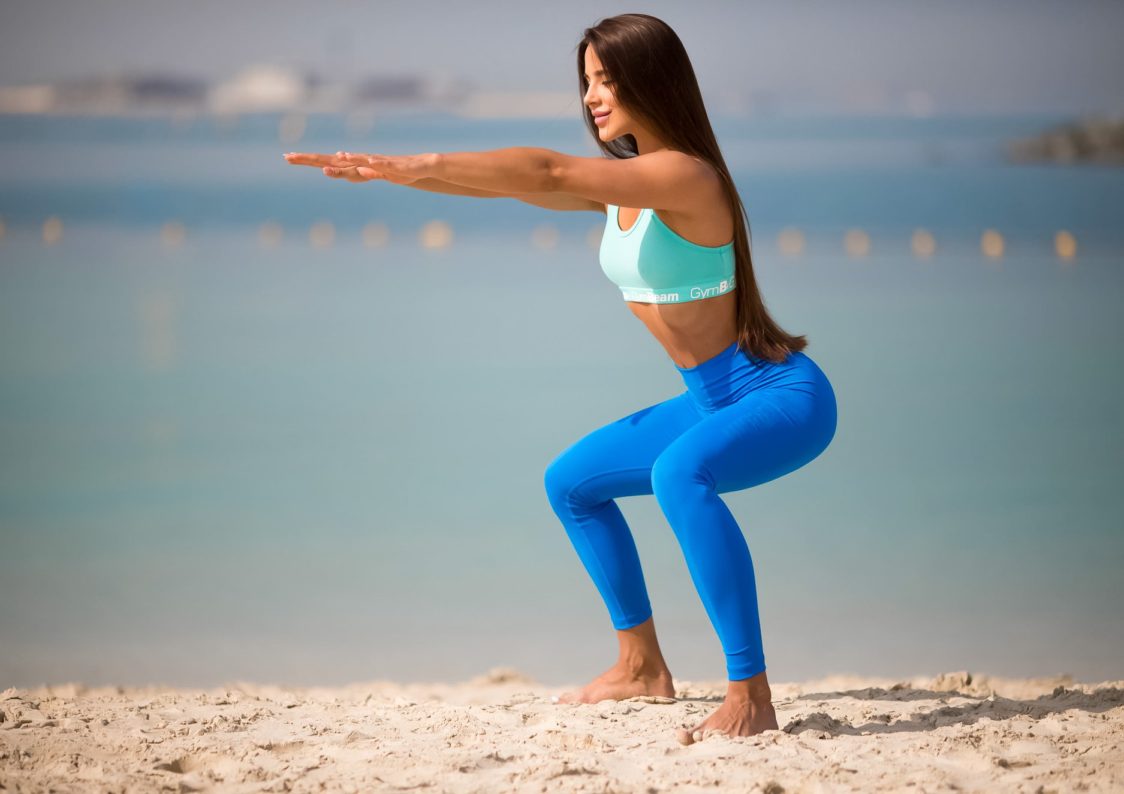
What muscles do you engage during squatting?
Squats are primarily designed to strengthen the leg muscles and butt. However, thanks to the correct posture during their performance and several variations of squats, you can engage many more muscles.
During a standard squat with your own weight, you engage:
- quadriceps thigh muscle
- hamstrings
- quads
- abductors
- butt
- straight abdominal muscle
- biceps calf muscle
If you use weights when squatting or try other variations of squatting, you can also engage the muscles of:
- back
- forearm
- shoulders
- external and internal abdominal muscles
- triceps
- biceps
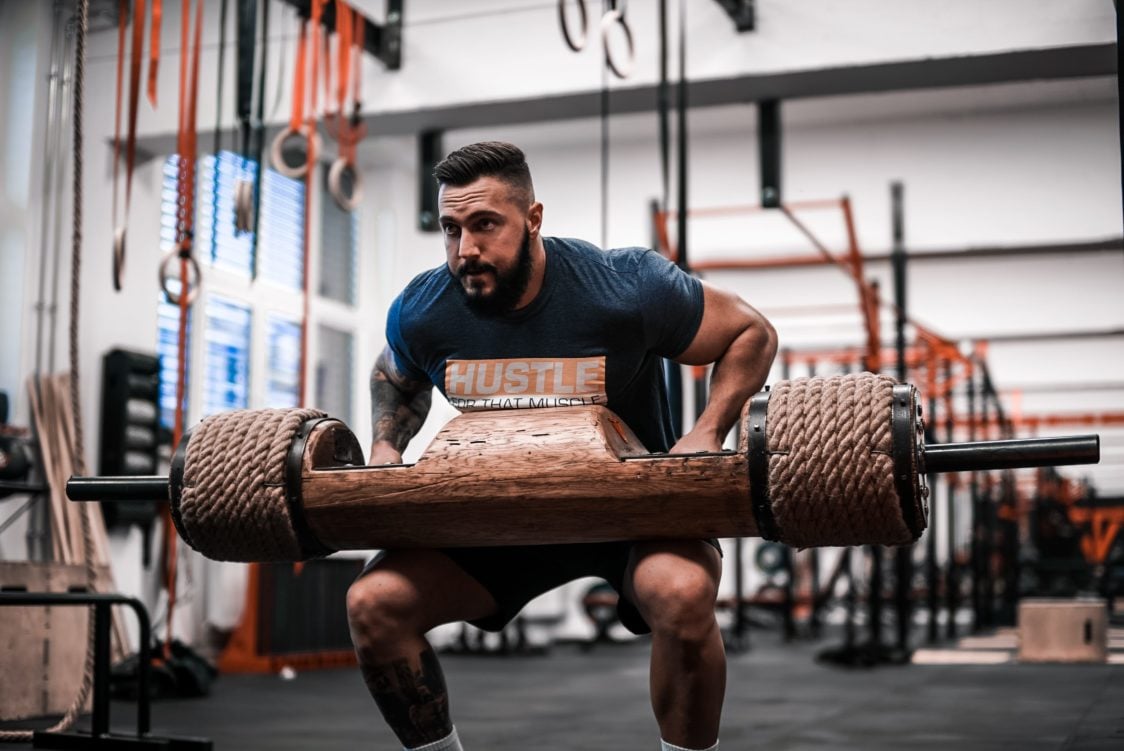
The proper technique to do a squat
The proper squat technique will help maximize your efforts and prevent unpleasant injuries or muscle pain. How to do it?
- Stand upright and spread your legs hip-width apart – toes facing forward.
- Push your shoulders back slightly and squeeze your abdomen.
- Stretch your shoulders or put your hands on your sides.
- Inhale, slowly lower yourself to the floor, bend your knees and push your butt back a little.
- Keep your back straight, do not bend it.
- Stop when you reach the squat position with your knees bent at a 90° angle and your thighs parallel to the floor – stay in this position for about 2 seconds.
- Push on your heels, slowly straighten up your legs, and return to an upright position with an exhale.
- For the best squat effect, repeat the exercise at least 10 to 15 times in a row.
For an even better understanding of the correct squat technique, watch the instructional video:
The most common mistakes when doing a squat
- You do not go low enough to the floor – with the right squat technique, your thighs should be parallel to the floor. However, if you do not go low enough and do not reach this point, you will not fully engage all the necessary muscles.
- Switching knees – a very common problem when performing a squat. Not only does this make it impossible to do a squat properly, but it also puts a lot of unnecessary load on your knees. This can damage your joints and tendons.
- You do not put your knees apart – when lifting from a squat, the knees should point outwards, not inwards. When you point your knees inwards, you will make it easier to squat, but then squatting makes no sense.
- Crouching – When squatting, it is extremely important to keep your back upright, otherwise it may lead to an injury. You should therefore avoid bending it or creasing it.
- You lift your heels off the floor – standing up from the squat should be accompanied by the pressure of the heels. This is because if you push your heels into the floor, you will ensure safe and correct muscle activation and balance. Therefore, never stand on tiptoe when lifting from a squat, but transfer all your weight to the heels.
Benefits of squats
Squats not only strengthen your muscles, but they also hide many other benefits. By performing them, you can also improve many basic activities such as walking, sitting, or lifting and carrying heavy loads. But that’s definitely not all! Find out what other benefits you will get by doing squats regularly.
- support proper posture
- help burn calories – an approximately 64-kilo person can burn up to 133 calories in 15 minutes of intense squatting
- improve flexibility and stability
- strengthen the lungs and heart
- help prevent injuries
- maintain joint health
- maintain strong bones
- improve movement speed
- improve digestion and blood circulation in the body
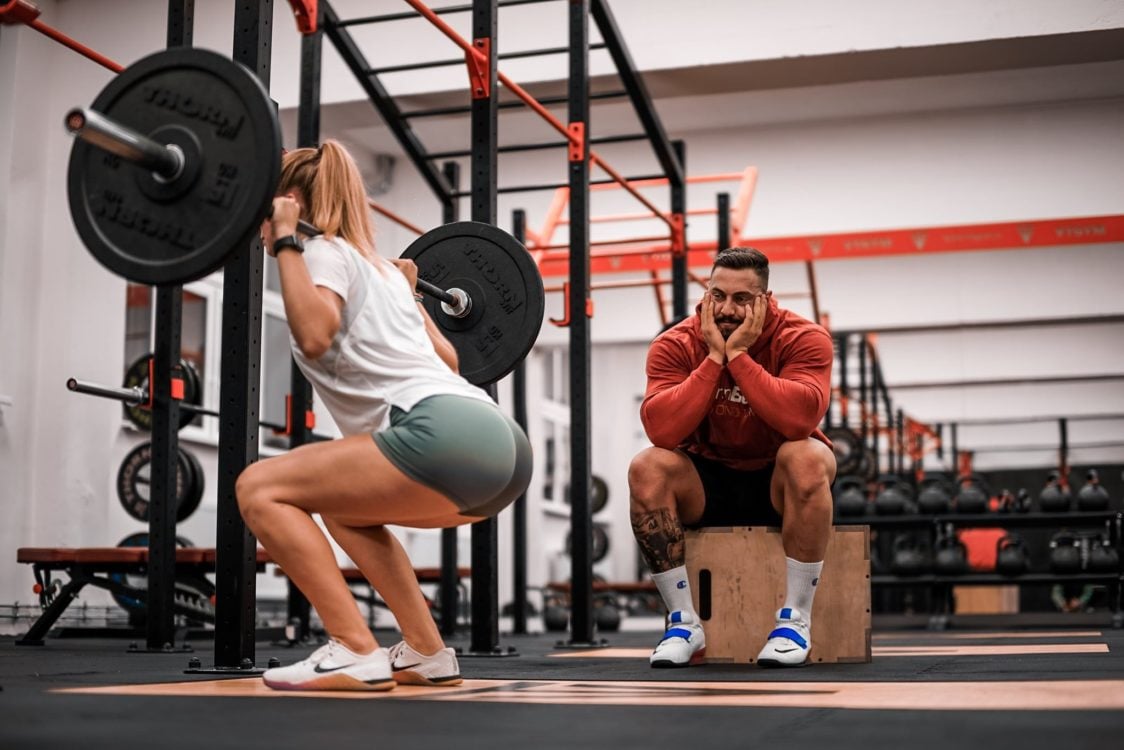
Squat variations
There are countless of them. Thanks to multiple variations of the squat, you will also engage other important muscles in the exercise and liven up your workout. However, remember that if you are new to working out and squatting, you should focus on understanding the proper technique of a basic squat, and then try other, more challenging forms of it. You can also use various tools, such as dumbbells, resistance bands and expanders, kettlebells, a chair or a balance pad. Look at what types of squats you can incorporate into your training plan.
Bulgarian Squats
Before performing Bulgarian squats, you need to prepare one exercise tool, which is a step, a lower chair, or a bench. Stand with your back to the step and bend your right foot so that you place the top of your foot on the step. This will be your starting position. Then bend the left leg at the knee and pull in a squatting motion to the ground until the knee of the right leg almost touches the ground. Make sure your shoulders are facing backwards, your back is straight, and you are not standing on your toes when lifting. If you want to make this exercise more difficult, you can do it while holding dumbbells.
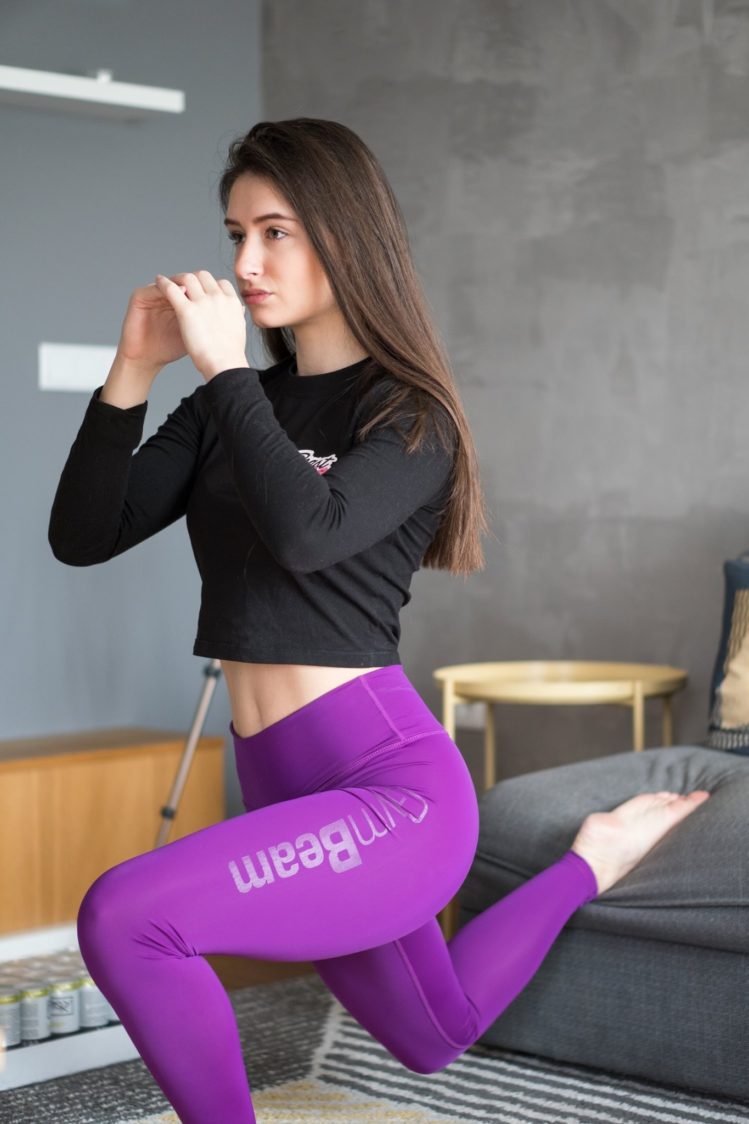
Sumo Squats
The width of your legs during this type of squat should be slightly larger than during a classic squat. So stand astride so that your legs are a little further apart than the width of your shoulders. Toes should point slightly to the outside. Push your hips and shoulders back, keep your back straight and lower into the squat. Stop only when your hips are slightly below the level of your knees.
Squat on the Smith Machine
Smith machine, or so-called multipress, is an excellent tool for anyone who has a problem squatting and maintaining a straight back. This machine always maintains one trajectory of movement, from which you will certainly not deviate. It is a classic squat technique, but with a weight placed on your traps. However, be careful not to stand on tiptoe due to the weight at the starting position or, conversely, not to be in a knee-bend position. Adjust the weight so that you feel comfortable and safe when exercising.
Squats with Weights
Once you master the basic squat technique with your own weight, it’s time to add some iron! There are several ways to do this. You can either add dumbbells, kettlebell or barbell, to the squat. When using dumbbells, make sure that their weight does not automatically push you more to the ground with your chest. When using the barbell on your back, make sure that you do not overdo it with the scales and cause yourself some injury.
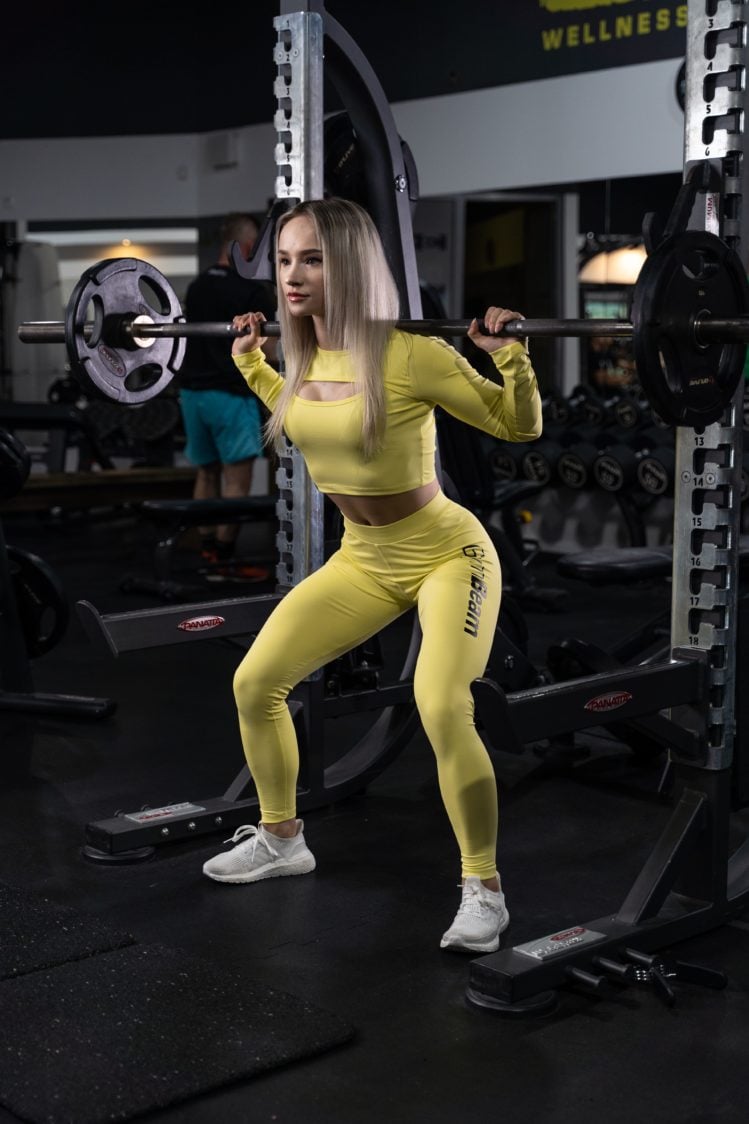
Overhead Squats
In addition to the lower parts of your body, this variation of the squat will also engage your core and the muscles of the back, shoulders, and arms.
The starting position of the squat is the same as with the classic squat, but we keep our hands upright above our heads. To make this exercise more difficult, add weights in the form of a barbell, kettlebell, or an exercise ball.
Squat Jump
It is a plyometric movement, which actually means that you perform aerobic exercise with this type of squat. It therefore requires that you make as many movements as possible in the shortest possible time. The technique of a squat jump is identical to the classic squat, but when lifting from the ground, you push a little more with your heels and jump out. We recommend adding weights to this type of squat only when you have really mastered this technique.
Wall Sit
Stand with your back to the wall and slowly move to the squat position. Your back and head must touch the wall at all times. Slowly move your legs away from the wall to create a basic squat position – your knees are bent at a 90° angle, your toes point forward and your thighs are parallel to the floor. You should remain in this position for at least one minute. You can place a barbell or kettlebell on your knees to make this exercise more difficult. Although it is not a dynamic type of squat, it will definitely challenge your thigh muscles and butt.
Side Squat Walk
Again an aerobic kind of squat. Stand in the starting position of a classic squat and slowly move down. However, stay in this position, do not lift up, but take a step to the side with your right foot. Make sure that your thighs are still at the same height during this movement. Then repeat the same movement with the left foot so that you get back to the squat position. You can repeat the movement several more times to one side and then swap the sides. You can also use a resistance band or an expander to make it harder to squat.
Single-Leg Squat
An ideal squat for the best possible exercise of thigh muscles and butt, but also to gain better stability. Take the starting position of a classic squat and then stretch one leg in front of you. Slowly move down, to the squat position. You can outstretch your arms to get the best balance possible. Keep your foot still outstretched. Just crouch as much as your body lets you go. Do not switch knees and try to maintain the best possible stability.
Plié Squat
The best kind of squat for toning your legs, the technique of which is not at all similar to the classic one. Take a position like during a sumo squat with a wider position, spread or stretch your arms and move towards the squat. During a plié squat, however, your weight doesn’t stay on your heels, but shifts to the toes. Therefore, stand on your toes with your squats and press your knees apart so that you feel as much pressure on the inner thigh muscles as possible. This ballet-inspired squat is especially popular with women.
Of course, there are many variations of squats, so we have chosen the top most basic and most popular for you. What about you and squats? Do you include them in your training plan? What kind of squat do you like best?






